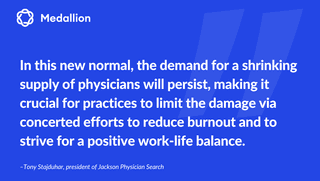6 key takeaways from MGMA's Back from Burnout: Confronting the Post-Pandemic Physician Turnover Crisis report
We break down the top surprising takeaways from the new Medical Group Management Association (MGMA)'s report on amplifying the understanding between physicians and administrative leaders of the burnout crisis and effective retention strategies.

While the world saw monumental gains in the fight against COVID-19, after three long, challenging years, the data confirms the rising toll of stress during the pandemic, staffing shortages, and burnout is fueling physician turnover.
To help healthcare organizations address provider burnout, the Jackson Physician Search, in partnership with the Medical Group Management Association (MGMA,) just released the report, The Physician Burnout, Engagement, and Retention Survey.
Data and insights indicate how healthcare organizations are trying to influence physician recruitment, engagement, retention, and burnout mitigation. In contrast, it includes how the clinical and administrative sides perceive these efforts.
The survey was fielded in August 2022 and surveyed physicians and healthcare administrators from the Medical Group Management Association's database.
Here are six surprising takeaways from the report:
4 in 10 medical practices had a physician resign or retire early in the past year due to burnout.
More than one-third of physicians considered early retirement over the past year, and forty-one percent considered leaving the practice of medicine altogether due to feelings of burnout and stress.
The MGMA report recommends healthcare organizations seek expanded benefits such as better clinical support, flexible schedules, and more paid time off to alleviate challenges related to provider burnout. In the survey, a growing share of physicians (62%) pointed to retention programs as somewhat or very important to their satisfaction, up from 59% in 2021.
Organizations with physician retention programs found them effective in engaging doctors and preventing turnover. Healthcare organizations unwilling to focus on this area are likely to lose providers.
Administrators acknowledge worsening levels of burnout in physicians, but physicians often don't perceive enough is being done to mitigate that burnout or engage them.
Physician burnout—the long-term, cumulative stress and depersonalization that doctors experience amid growing burdens in medicine — continues to pose a significant threat to the healthcare industry in dire need of clinical leaders.
For healthcare organizations, incorporating strategic physician retention plans with dedicated wellness and counseling services may help alleviate the risk of burnout. The MGMA report recommends that in addition to establishing wellness committees to plan and manage organized efforts to address physician work-life balance, there should be greater access to mental health resources. Additionally, peer-to-peer counseling, life coaching, and time management training.
A study in Mayo Clinic Proceedings estimated that primary care physician turnover, fueled partially by burnout, leads to nearly $1 billion in excess healthcare spending each year.
The MGMA report shows that only5% of physicians said they experienced a decrease in burnout in the past year. There are vital areas administrators are looking for that can help address burnout, specifically around updated or flexible schedules.
For example, the four-day work schedule is the new standard to ensure physicians can take more time off. Others report reducing physicians' call responsibilities or ensuring they get a day off after being on-call can also help.
A growing share of administrators reports they are even creating part-time positions for physicians who no longer wanted a full schedule but were not ready to retire or leave the profession. It's a critical area to consider for healthcare organizations spending time and money hiring new providers–and a future consideration could come down to weighing the outcome if they can reallocate the time and money to providers with lower caseloads or licensing.
One practice leader pointed to pain points in the EHR for clinicians: "All the extra clicks suck the life out of everyone."
A recent American Medical Association (AMA) playbook for saving time within a physician practice highlights the ongoing need to eliminate "stupid stuff" from physicians' workflows and others based on a program from Hawaii Pacific Health. The program highlighted more than 300 time-wasting EHR activities that could be removed.
Other efforts to ensure faster resolution of minor operational issues are also cited as ways to allow physicians to focus on patient care and not feel bogged down by administrative matters or revising the number of meetings physicians must attend. One consideration for healthcare organizations might be embracing automation to improve workflows and leverage the right tools to help increase efficiency and enable providers to do more in one place.
The #1 factor in work satisfaction is "two-way communication with management/administration."
Genuine, two-way communication between management/administration and physicians remains a top desire among physicians.
For healthcare organizations, consider limiting how much time physicians spend in meetings and ensure the communications between administrators and physicians are concise and impactful, tailored to physicians' concerns.
Additionally, it's vital to get input from physicians and acknowledge their feedback in the decision-making process.
Reduced administrative burden ranked #5 in importance when weighing work satisfaction.
For healthcare organizations optimizing EHRs, improving ease of charting, and using nurse practitioners (NPs) and physician assistants (PAs) to help with doctors' electronic in-baskets reduces a significant amount of paperwork.
For healthcare organizations, it's worth taking a good, hard look at whether administrative teams have enough capacity to give your providers what they want. If not, evaluate what it'll take to get there and again weigh the options of turning to platforms like Medallion that make it worth not having to hire again or are worth high provider retention rates.
Looking ahead
The MGMA report points to an immediate need for healthcare leaders to redouble their efforts to address physician burnout after nearly three years of pandemic pressure. While the provider burnout epidemic is a hot issue for discussion, it's essential to recognize the growing number of healthcare leaders taking necessary steps to act and formalize efforts into initiatives and programs that put provider well-being and retention out front. Finally, as patient care needs continue to intensify and evolve, recruiting and retaining top physician talent will be most important to an organization's culture and bottom line.
Read more: The Physician Burnout, Engagement, and Retention Survey


